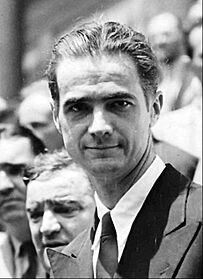Howard Hughes Medical Institute facts for kids
| Founded | 1953 |
|---|---|
| Founder | Howard Hughes |
| Focus | Biological and Medical research and Science Education |
| Location | |
| Method | Laboratories, Funding |
|
Key people
|
|
|
Revenue (2022)
|
-US$2.303 billion (due to losses on investments) |
| Expenses (2022) | US$853 million |
| Endowment | US$24 billion |
|
Employees
|
2,300 (2022) |
| Website | hhmi.org |
The Howard Hughes Medical Institute (HHMI) is an American non-profit organization that supports science. It gives money to scientists who are doing important medical research. It is one of the biggest private funders for biology and medical research in the United States.
The institute is located in Chevy Chase, Maryland. It was started in 1953 by Howard Hughes. Hughes was a famous American businessman, pilot, and movie director. He was one of the richest people in the world during his lifetime.
HHMI has a very large amount of money saved for its work, called an endowment. Its endowment is over $22 billion. This makes it one of the wealthiest organizations of its kind in the world. The institute helps top scientists, called HHMI Investigators, by giving them about $1 million each per year for their research.
Contents
The Story of HHMI
The Howard Hughes Medical Institute was created with a big goal. Howard Hughes said he wanted it to discover "the genesis of life itself," which means the very beginning of life.
Early Years
When it first started, some people thought the institute was just a way for Howard Hughes to avoid paying taxes on his fortune. Hughes was the only person in charge. He moved his ownership of the famous Hughes Aircraft Company to the institute. This meant a company that built airplanes and defense technology was now owned by a charity.
For many years, the U.S. government questioned whether HHMI was truly a charity. Because of this, the institute began to fund a small number of scientists at different universities. But for a long time, it was not a very large organization.

A Time of Big Changes
Howard Hughes died in 1976. Since he was the only person in charge and didn't leave a will, there were many court cases to decide what would happen to his money and the institute.
After the legal issues were settled, new leaders were put in charge of HHMI in 1984. They decided to sell the Hughes Aircraft Company. In 1985, General Motors (GM) bought the company for about $5.2 billion.
This sale gave the institute a huge amount of money. Suddenly, HHMI grew from a small organization into a major force in science. Its budget for funding research grew from $15 million in 1978 to over $200 million after the sale.
What does HHMI do today?
Today, HHMI uses its large endowment to support science in many ways.
- Funding Researchers: Its main job is to find the best scientists in the country and give them the freedom and money to work on big, challenging questions in biology and medicine.
- Science Education: HHMI also works to improve science education for students of all ages, from elementary school to college.
- Open Access Science: In 2022, HHMI began requiring that all research papers from its scientists be made free for anyone to read as soon as they are published. This is called open access, and it helps share scientific knowledge with the world.
Important Locations
The institute was first based in Florida. It moved a few times before settling in its current headquarters in Chevy Chase, Maryland, in 1993.
In 2006, HHMI opened a special research center called the Janelia Research Campus in Ashburn, Virginia. It is a place where scientists from different fields can live and work together to solve tough problems in science. The main lab building is almost 1,000 feet long!
See also
 In Spanish: Instituto Médico Howard Hughes para niños
In Spanish: Instituto Médico Howard Hughes para niños
- List of wealthiest charitable foundations
-
Main category: Howard Hughes Medical Investigators

